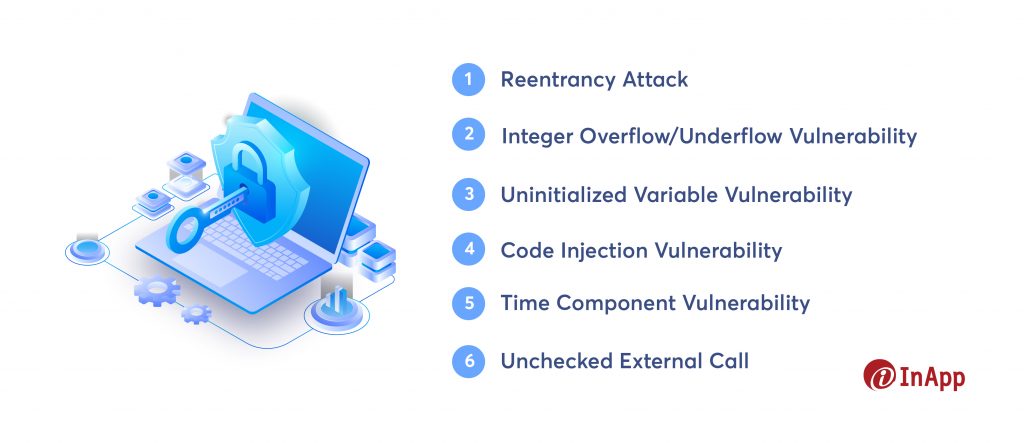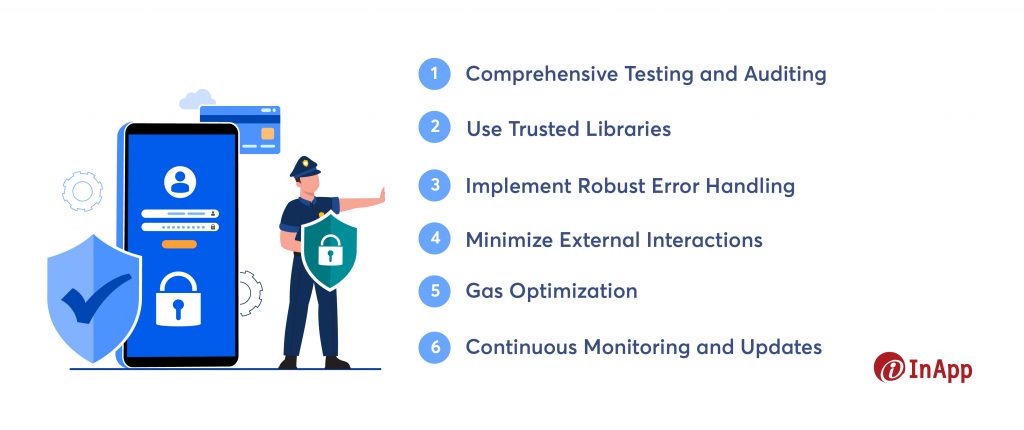In blockchain technology, smart contracts stand as the bedrock of innovation. Smart contracts are like digital agreements on blockchain, and they’re supposed to make things safe and secure.
But, as we delve deeper into the world of smart contracts, an essential question looms: How safe are they?
According to Bankless Times, the funds lost through smart contract hacks surged to a staggering $2.7 billion, representing a jaw-dropping 1250% increase since 2020.
The immutability of smart contracts, which were intended to ensure security, has become a significant vulnerability. Once these contracts are deployed on the blockchain, there is no flexibility to address or reverse vulnerabilities. This inherent risk has made smart contracts an attractive target for malicious actors.
In this blog post, we will delve into the top six smart contract vulnerabilities that have become the Achilles’ heel of blockchain systems, shedding light on the challenges and risks they present in our quest for a secure and decentralized future.
Top Six Smart Contract Vulnerabilities

#1. Reentrancy Attack
A reentrancy attack is where attackers take advantage of the way smart contracts interact with each other on the blockchain, particularly when handling cryptocurrency or digital assets. In a reentrancy attack, a malicious contract tricks another contract into executing a function it wasn’t supposed to during a transaction, often resulting in unauthorized access to funds or unintended consequences.
Here’s an example to illustrate a reentrancy attack:
Imagine you have a smart contract for a decentralized bank where users can deposit and withdraw funds. The contract contains a “withdraw” function, allowing users to retrieve their funds. To do this, it updates the user’s balance and sends them the requested amount.
Now, imagine a scenario where an attacker comes along and creates a malicious contract. They open an account with your bank and deposit some cryptocurrency. Then, they initiate a withdrawal from their account in the savings contract.
The contract doesn’t immediately process the withdrawal. Instead, it temporarily records that the attacker is due a certain amount of cryptocurrency as part of the pending withdrawal request. (This recording is necessary because smart contracts often perform multiple operations within a single transaction, and they need to keep track of the state changes they intend to make before committing them. )
Now, the malicious contract takes advantage of this situation. It has a special function called a callback function, which the attacker’s contract previously told the savings contract to call.
In the callback function, the malicious contract exploits the situation by re-entering the bank contract and initiating another withdrawal. Since the bank contract still believes it owes the attacker funds, it processes this second withdrawal request, and the attacker essentially double-dips, withdrawing more funds than they should have.
In short, the reentrancy attack exploits the callback mechanism and the savings contract’s belief that it owes funds to the attacker, allowing the attacker to repeatedly withdraw funds they shouldn’t have access to.
#2. Integer Overflow/Underflow Vulnerability
Integer overflow and underflow vulnerabilities are common issues in smart contracts that can lead to unexpected behavior or even security breaches. These vulnerabilities occur when the result of an arithmetic operation on integers exceeds the maximum or goes below the minimum representable value.
For a better understanding, consider this example.
Imagine you have a smart contract that represents a digital wallet. This wallet can receive and send a certain number of coins, and its balance is stored as an integer.
Let’s say the wallet starts with a balance of 100 coins. Now, a user wants to receive 150 coins in their wallet. If the smart contract doesn’t have proper checks in place, it might not be able to handle this situation correctly. Instead of stopping at 100 coins (the maximum balance), it could overflow and wrap around to a negative number. So, the wallet’s balance could end up as -46 coins. This is an Integer overflow vulnerability.
With the Integer Underflow vulnerability, assume the wallet balance is 10 coins, and the user wants to send 20 coins to someone. Without adequate safeguards, the contract might allow the transaction to proceed. Instead of stopping at 0 coins (the minimum balance), it could underflow and wrap around to a very large positive number. So, the wallet’s balance could end up as an unintended large positive value.
#3. Uninitialized Variable Vulnerability
The uninitialized variable vulnerability occurs in smart contracts when a variable is not given an initial value before it’s used in calculations or operations. This can lead to unexpected and potentially harmful outcomes because the variable’s value is undefined.
This vulnerability poses significant security risks because it can be exploited by malicious actors to manipulate contract behavior in their favor, potentially leading to financial losses or other unintended consequences.
#4. Code Injection Vulnerability
Code injection vulnerability occurs in smart contracts when an attacker manages to insert malicious or unexpected code into a contract’s execution, leading to unintended and potentially harmful actions. This vulnerability can allow an attacker to manipulate the contract’s behavior or steal assets.
Code injection vulnerabilities pose severe risks to contract integrity and user funds. To mitigate this threat, developers should implement robust input validation and avoid relying solely on external data sources. Auditing and testing contracts thoroughly can help identify and prevent such vulnerabilities, ensuring the security and trustworthiness of smart contracts on the blockchain.
#5. Time Component Vulnerability
A time component vulnerability in smart contracts refers to a security weakness that arises when a contract’s behavior is influenced by the passage of time. This vulnerability can be exploited by attackers to manipulate the contract’s logic or timing to their advantage.
For example, if a contract relies on a timestamp to trigger certain actions, an attacker may attempt to manipulate the timestamp or force the contract to execute prematurely. This can lead to unexpected outcomes, such as unauthorized access to funds or resources.
Common instances of time component vulnerabilities include timestamp dependence for access control, delayed execution, or rate calculations. To mitigate these vulnerabilities, developers should use secure time sources (like block timestamps in blockchain) and implement proper checks and validations in their smart contracts.
#6. Unchecked External Call
Unchecked external call vulnerability occurs when a smart contract interacts with external contracts or addresses without adequately checking the consequences of these interactions. This can lead to various security issues, including reentrancy attacks and unexpected behaviors.
In this vulnerability, a contract fails to perform essential checks or handle exceptions properly when making external calls. For example, it may not verify the success of a token transfer or delegate calls to untrusted contracts without proper safeguards.
This oversight can enable malicious actors to exploit the contract’s vulnerabilities, potentially draining funds or causing unintended outcomes. It highlights the importance of thorough testing, secure coding practices, and carefully validating external interactions to prevent unchecked external call vulnerabilities in smart contracts.
How to Avoid- Smart Contract Vulnerabilities?
Smart contracts are powerful tools on the blockchain, but they are not immune to vulnerabilities. Ensuring the security of your smart contracts is paramount to protect against financial losses and security breaches. Here are six essential steps to fortify your smart contracts and reduce the risk of vulnerabilities.

1. Comprehensive Testing and Auditing
Before deploying your smart contract, rigorously test it on various blockchain testnets to identify and fix potential issues. Consider professional smart contract auditing services to obtain expert insights into vulnerabilities and recommendations for improvement.
2. Use Trusted Libraries
Leverage well-established libraries and existing code for core functionalities, such as token standards (e.g., ERC-20, ERC-721). These libraries have undergone extensive testing and peer review, reducing the likelihood of vulnerabilities.
3. Implement Robust Error Handling
Incorporate fail-safe mechanisms to gracefully handle unexpected scenarios. Utilize the “require” statement for condition checks and “revert” for error handling. Employ the checks-effects-interactions pattern to minimize reentrancy vulnerabilities.
4. Minimize External Interactions
Limit interactions with external contracts to those that are trusted and well-audited. Be cautious when calling untrusted contracts, as they may contain vulnerabilities that can be exploited. Use secure communication channels, like oracles, for external data inputs.
5. Gas Optimization
Optimize your smart contract’s gas usage to avoid exceeding the gas limit, which could result in transaction failures. Pay special attention to complex or recursive operations and streamline them whenever possible.
6. Continuous Monitoring and Updates
Stay up-to-date with the latest security best practices and blockchain technology changes. Regularly audit and update your smart contracts to address new vulnerabilities and emerging threats.
By following these steps, you can significantly enhance the security of your smart contracts and reduce the risk of vulnerabilities. Remember that smart contract security is an ongoing process, requiring vigilance and a proactive approach to maintain the integrity of your blockchain applications.
Fortify Your Smart Contracts in The Evolving Crypto World
In the rapidly evolving world of blockchain and cryptocurrency, staying informed about smart contract vulnerabilities is not merely a matter of choice; it’s an imperative. As we’ve explored the top vulnerabilities of 2023, it becomes evident that the risks are real and potentially costly. Ignorance is not bliss in this realm.
To safeguard your investments and assets, it’s essential to be proactive. Start by regularly educating yourself on the latest threats and mitigation strategies. Engage with the blockchain community, follow industry experts, and remain vigilant. Always double-check your smart contract code and seek third-party audits. Implement security best practices religiously.
Remember, smart contracts are a powerful tool, but they are only as secure as the hands that wield them. By making security a top priority and staying informed, you can navigate the blockchain landscape with confidence and protect your digital assets.
Frequently Asked Questions
Are Smart Contracts legally binding?
Yes, smart contracts are generally legally binding. While acceptance varies globally, many jurisdictions recognize the enforceability of smart contracts. Their legality depends on meeting traditional contract elements: mutual consent, offer and acceptance, and consideration.
It is recommended to consult legal professionals for jurisdiction-specific advice to ensure compliance and clarity in smart contract implementation.
Can smart contracts be changed and updated?
No, smart contracts are immutable meaning they cannot be changed or updated once they are deployed on the blockchain. This feature ensures trust and security in transactions by preventing manipulation. Any desired modifications require deploying a new contract.
